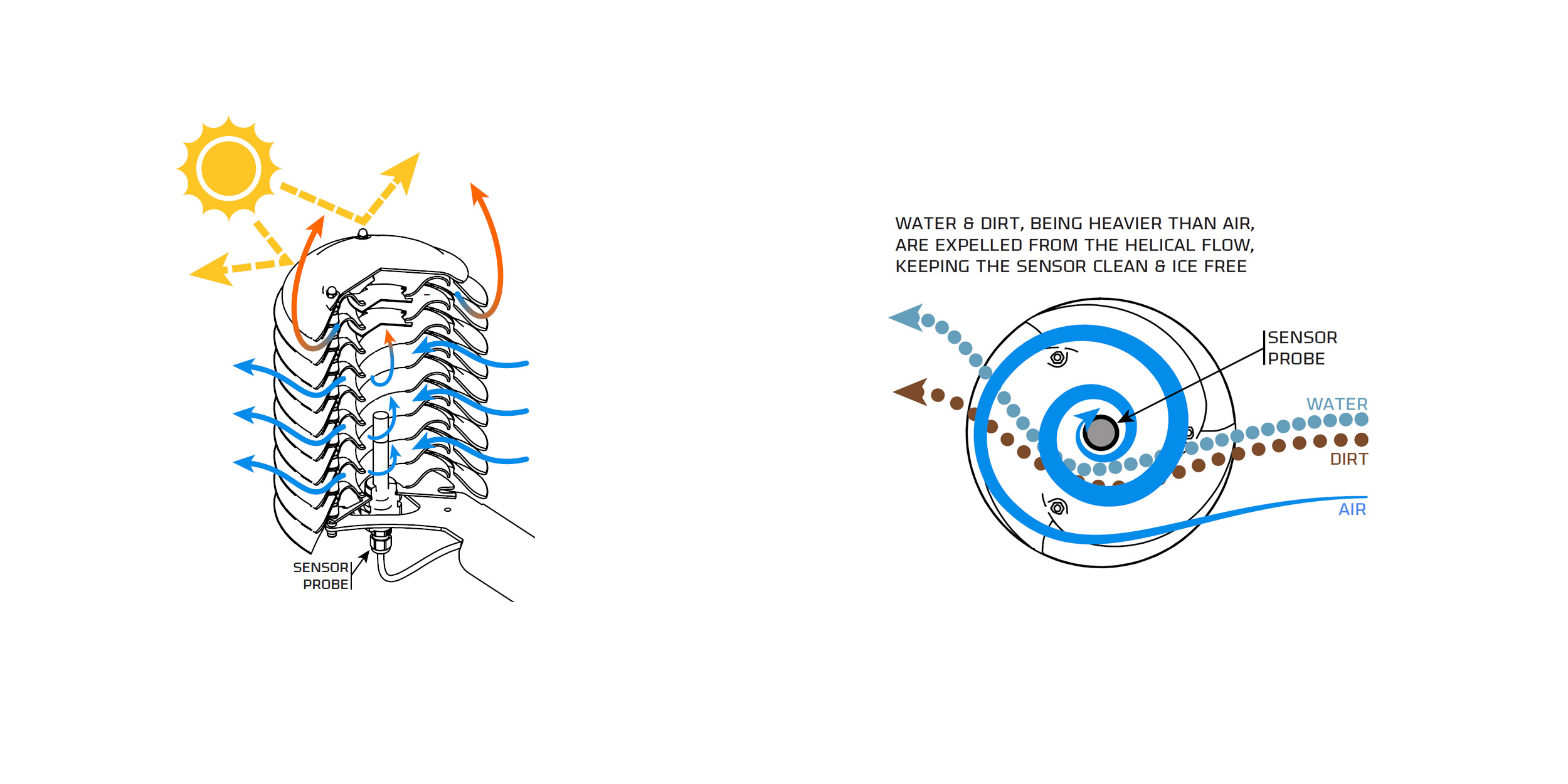BLACK or WHITE
We painted one radiation shield black.
Compared it side-by-side to the original.
To find the limit of performance of the helical MeteoShield.
The BLACK & WHITE MeteoShield Comparison
To see the limits of performance for the helical radiation shield design we decided to break all the rules.
WHY?
- If a radiation shield gets soiled and dirty, how does it effect temperature?
- How dirty can a radiation shield get before unacceptable errors enter your measurements?
Since all radiation shields in comparison studies are white, we asked ourselves...
"Has anyone tried painting a radiation shield black to find its limits of performance?"
THE QUESTIONS WE HAD:
- How much will the outer louvers heat up?
- How much heat will get transferred from the outer louvers to the inner louvers to heat up the air inside?
WEATHER CONDITIONS of the test:
- Solar radiation of 1000-1100W/m2 maximum (irradiation)
- Solar angle 65°...75° (height/elevation of the sun above the horizon)
EVALUATION CRITERIA
Largest sun induced temperature error occurs when wind is low and sun is at a moderate elevation angle so that a large area of a radiation shield is exposed to solar heating. We chose to group the results into two categories. Conditions with wind less than 1m/s (2.3mph) to record the largest possible measurement error and conditions with higher wind.
THE SURPRISE, RESULTS
For wind speed above 1 m/s (2.3mph) and less than 2 m/s, the mean measurement error was 0.31°C for a black painted helical radiation shield with a maximum deviation of 0.43°C. Even heavy dirt, sand or dust in your application will not come close to the extreme black paint in this test. Therefore, for road-side weather stations, smart city sensors or any dirty environment, the MeteoShield -Professional can be considered maintenance free and dirt buildup will not have a measureable effect on its performance.
- Dirt and dust have no measureable effect on temperature accuracy of METEOSHIELD PROFESSIONAL above 1 m/s
Below 1 m/s wind speeds, the mean temperature error was only slightly increased to 0.33°C with a maximum recorded short term deviation of 0.47°C. This was quite unexpected, as below 1m/s wind speeds, multi-plate radiation shields/screens unusually perform much worse. We attest this uniquely stable temperature measurement to the helical shield design which eliminates the hot-air-bubble effect of traditional designs.
- High temperature measurement stability of the helical radiation shield design is shown at calm conditions below 1 m/s (2.3mph).
RADIATION SHIELD COMPARISON TEST RESULTS
| WHITE | BLACK | NOTES | ||
| Less than 1m/s wind, Max irradiation 1000-1100W/m2 | ||||
|---|---|---|---|---|
| Max temperature | 35.75°C | 36.22°C | 0.47°C | maximum short-term temperature difference |
| Mean temperature | 34.90°C | 35.23°C | 0.33°C | average short-term temperature difference |
| Min temperature | 33.66°C | 33.91°C | 0.25°C | minimum short-term temperature difference |
| 1m/s to 2m/s wind, Max irradiation 1000-1100W/m2 | ||||
| Max temperature | 35.71°C | 36.14°C | 0.43°C | maximum short-term temperature difference |
| Mean temperature | 34.85°C | 35.16°C | 0.31°C | average short-term temperature difference |
| Min temperature | 33.69°C | 33.91°C | 0.22°C | minimum short-term temperature difference |
CONCLUSION
based on the results, A helical shield design offers HIGH measurement stability in dirty environments.
we highly recommend it for smart city IOT & ROAD weather station applications.
About this test
This test was performed purely out of curiosity. It ran for over three months from April to August 2017 in the Northern Hemisphere (Europe) with GPS coordinates of: latitude 48.1, longitude 17.9. An anemometer (MeteoWind) was always present on the site so that effects of wind can be evaluated. On August 4, 2017 the perfect conditions for evaluation finally arrived with with clear skies, strong sun and high temperatures exceeding 35°C with stable wind below 1 m/s. A prototype pyranometer was installed in early June, before the strongest sun irradiation of the summer solstice so that solar radiation could be evaluated.
- Test coordinator of this radiation shield comparison is an avid storm chaser and one of the founding members of StormChasers.sk.
- He is also a member of Barani Design team that invented the helical radiation shield and was the coordinator of prototype testing & evaluation to finalize the design before it went into production.
- Download raw data from this radiation shield comparison test below or by writing to us via our Contact us page.
HOW THE HELICAL RADIATION SHIELD WORKS
- The spiral air flow pattern inside the shield maximizes ambient air flow around the sensor which is the secret to its superb performance.
- The spiral flow inside the shield has an eye in the center around the sensor (synonymous with the eye of a storm like in a tornado or a hurricane ) where clean air is found without debris or rain drops which keeps your sensor clean for more stable & accurate long-term measurement.
PATENTED
NATURAL ventilation
international PATENT
VIA EUIPO/OHMI





